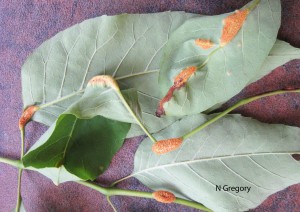
EMERALD ASH BORER has been found in several surrounding states, but has NOT been found in Delaware to date. An article appeared in the 6/20/15 Wilmington News Journal regarding trapping efforts and preparedness for the detection of the invasive emerald ash borer in the state: http://www.delawareonline.com/story/news/local/2015/06/19/firewood-carries-unwanted-travelers/289815.... This is one of many cooperative efforts in Delaware between Delaware Department of Agriculture, USDA, University of Delaware, and many municipalities. Traps are specifically designed to attract and detect nearby emerald ash borer, which only feeds on ash, and another related tree, Chionanthus. A trap will not lessen the damage, those traps are only put out in certain locations in an attempt to detect low populations of the insect should it arrive in Delaware. If we detect very low numbers, we have a better chance of eradicating the pest. Ash, however, is attacked by numerous other insects (lilac/ash borers) and several plant disease causing organisms such as those causing anthracnose, rust, heart rot, ash yellows and ash decline. In Delaware, if you suspect you may have EAB in your ash trees, contact the Delaware Dept of Ag's Plant Industries Section at (302) 698-4586.
Keeping ash trees free of insect pests, woodpecker damage and plant diseases is best done by keeping trees healthy and reducing stress on trees. Water during times of drought, have trees pruned by a reputable company if there is significant dieback of branches, and avoid wounding if possible.
NFG 6/23/2015
Tag: ash trees
Ash Rust is Here!

We see ash rust almost every year, but this year there seems to be quite a bit of it. The fungal rust disease is very dependent on the spores produced by the alternate host (Spartina marsh grass). In cool, humid seasons with a bit of wind, infections are numerous on ash leaves as they expand. There is no control at this time. Rake up and remove leaves that fall, as they will produce spores that go back to the marsh grass. The ash trees can tolerate some infection year after year, but it does look unsightly. There is usually no need for chemical control, but fungicides would need to be applied preventatively, so mark your calendar for next year during the second week of May, to check your trees. At that time, a fungicide such as myclobutanil could be applied to specimen trees, according to the label.
